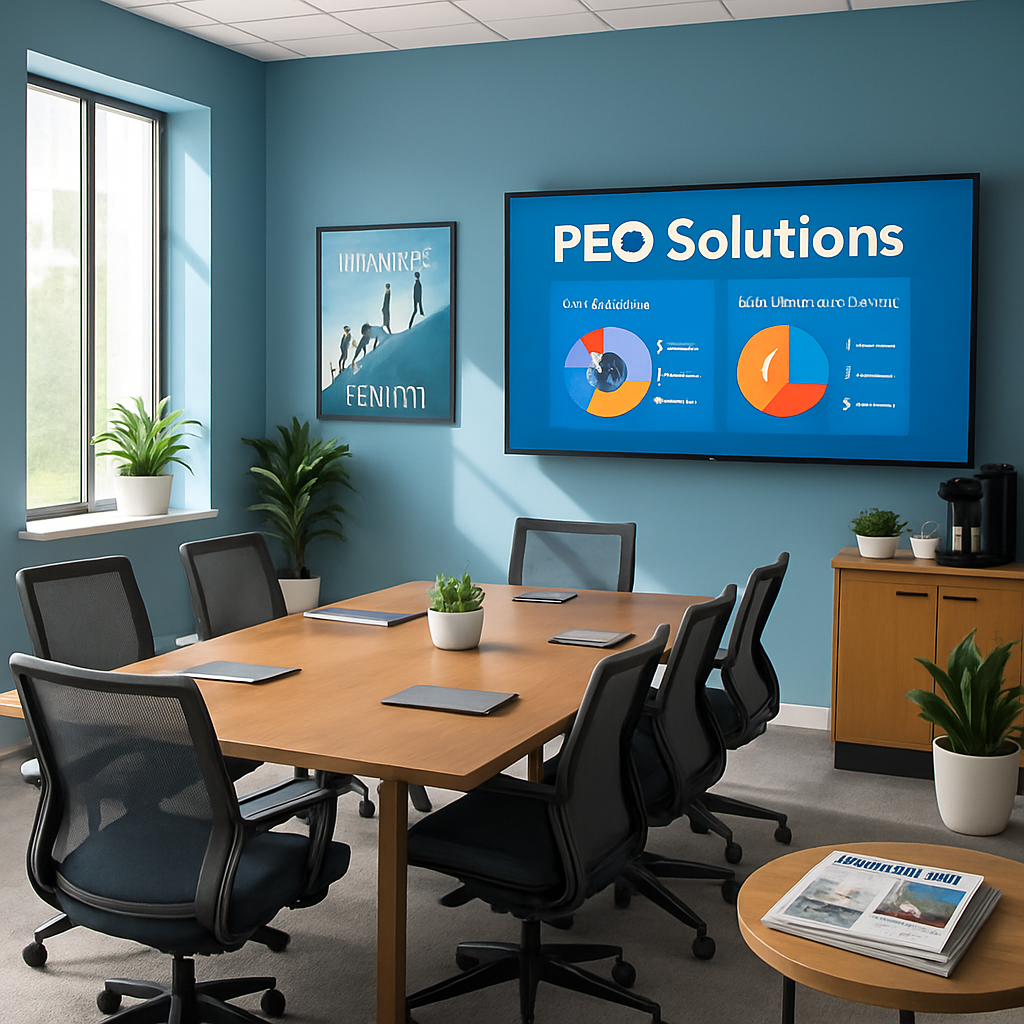- Home /
- The EaseBlog /
- PEO
The EaseBlog: PEO

The Essential Guide to HR Compliance in 2024
Staying on top of ever-changing HR compliance regulations is a monumental challenge for companies of all sizes. Even the most diligent HR departments struggle to keep pace with the complex web of federal, state, and local laws governing nearly every aspect of the employee lifecycle. However, vigilance in this area is critically important. Failing to adhere to employment laws and guidelines exposes organizations to substantial legal liability, fines, and reputational damage.
Below, we'll explore what HR compliance entails, look at common pitfalls, and discuss best practices for creating a compliant workplace. By understanding HR compliance fundamentals and partnering with experts, you can avoid non-compliance landmines and create a fair, equitable environment for your workforce. Now, let's start with the basics.
What is compliance in Human Resources?
HR compliance refers to the policies, procedures, and best practices organizations implement to adhere to the myriad of employment laws and regulations governing the workplace. At its core, compliance means creating an ethical, equitable environment for employees by safeguarding their rights and providing fair pay and treatment without discrimination.
In the United States, compliance involves navigating a complex web of federal, state, and local statutes enforced by agencies like the Equal Employment Opportunity Commission (EEOC), Department of Labor (DOL), and Occupational Safety and Health Administration (OSHA). The costs of non-compliance can be severe, from lawsuits and fines to irreparable reputational damage.
Now that we've defined compliance as it relates to Human Resources, let's look at some integral responsibilities of HR professionals and business owners when it comes to compliance.
Why does HR compliance matter?
HR compliance is essential for any organization that employs workers. Though complex and time-consuming, dedicating resources to compliance provides immense value and protection.
First and foremost, compliance minimizes legal risks that can devastate companies. Violating employment laws triggers fines, lawsuits, and settlements that jeopardize finances and reputation. No business wants to end up embroiled in a high-profile compliance scandal.
Beyond avoiding penalties, compliance fosters a fair, equitable, and safe workplace. Employees want to know their rights are protected. They will be more engaged and productive when treated ethically without discrimination.
Additionally, compliance establishes order and consistency in HR policies from hiring and onboarding to performance reviews and terminations. Well-documented procedures applied uniformly to all employees reduces exposure to claims of unfair treatment.
The return on investment from compliance efforts - in risk reduction, reputation, recruitment, retention, and culture - is well worth the required investment of time and resources. With so much at stake, businesses must make compliance a top priority.
Who is responsible for compliance?
The responsibility for compliance extends across an organization. While the HR department plays a central role, compliance is not solely their duty. Rather, it requires a unified effort and buy-in from leadership, managers, and employees.
Ultimately, the buck stops with the CEO and executive team. They must fully support and resource compliance efforts for the organization to embed it in the culture.
HR owns developing policies, educating the workforce, monitoring compliance, and enforcing procedures. They cannot drive adherence alone.
Frontline managers must implement HR policies daily, identifying and escalating issues promptly. All employees need training to understand expectations.
Maintaining compliance is interdependent. If any part of the organization does not uphold standards, risk increases. By working collaboratively across functions, businesses create shared accountability for compliance.
But what does that compliance consist of? What are the major Federal laws and regulations that apply to your business?
What are the key federal employment laws?
Here are some of the most important federal employment laws HR professionals must monitor to maintain compliance:
- Title VII of the Civil Rights Act - Prohibits employment discrimination based on race, color, religion, sex, and national origin.
- Age Discrimination in Employment Act (ADEA) - Protects individuals over 40 from age discrimination.
- Americans with Disabilities Act (ADA) - Prohibits discrimination against qualified individuals with disabilities. Requires reasonable accommodations.
- Fair Labor Standards Act (FLSA) - Establishes minimum wage, overtime pay, and child labor requirements.
- Family and Medical Leave Act (FMLA) - Entitles eligible employees to take unpaid, job-protected leave for medical and family reasons.
- Genetic Information Nondiscrimination Act (GINA) – Protects employees from discrimination based on their genetic information.
- Occupational Safety and Health Act (OSH Act) - Governs workplace health and safety standards.
- Employee Retirement Income Security Act (ERISA) - Sets standards for employee benefit plans, including pensions and health plans.
- National Labor Relations Act (NLRA) - Protects employees' rights to organize and collectively bargain.
- Immigration Reform and Control Act (IRCA) - Requires verification of identity and work authorization for new hires.
These provide a starting framework, but state and local laws add further complexity.
What are some new state laws that impact HR compliance in 2024?
Here are some examples of new state and local compliance requirements organizations must adhere to:
- California has expanded paid sick leave, added leave for reproductive loss, and enacted workplace violence safety standards.
- Laws prohibiting cannabis discrimination and expanding retaliation protections also take effect in California.
- California has imposed industry-specific minimum wages for fast food, healthcare, grocery, and retail employers.
- New York City has passed laws mandating predictable scheduling and just cause termination standards.
- Many cities and states have "Ban the Box" laws limiting criminal history inquiries during hiring.
- State and local paid sick leave laws sometimes exceed federal requirements.
- Some jurisdictions prohibit salary history inquiries during hiring.
- States and cities continue passing pay equity and pay transparency laws.
- Non-compete agreements are restricted or banned in several states like California.
Understanding nuances across jurisdictions is imperative for multi-state employers. We'll discuss best practices for compliance next.
What are the best practices for HR professionals to ensure compliance?
Maintaining compliance requires diligence, but businesses can follow certain best practices to reduce risk:
Conduct regular training – HR compliance training ensures all employees, especially managers, understand their role and obligations. Training should cover discrimination, harassment, pay rules, safety protocols, and other topics. New hires need thorough orientation on policies and procedures. Consider annual refresher courses.
Document and update policies - A detailed employee handbook and accessible policy repository reinforces expectations. Update handbooks and policies as laws change. Have employees acknowledge receiving updates.
Perform audits - Periodic internal audits by HR identify gaps in processes or documentation. External audits provide unbiased assessment.
Use HR technology - HR information systems automate compliance related to hiring, payroll, time tracking, and benefits administration.
Monitor legal changes - Subscribe to newsletters and associations to stay current on legal and regulatory changes affecting your locations and industry.
Involve other functions - Finance, legal, IT, and operations all support compliance. Foster collaboration.
Overall, instilling a culture valuing transparency, diversity, and open communication makes employees partners in compliance, not adversaries. Proactive, preventive measures reduce the odds of serious issues arising.
However, even with robust efforts, the complexity of compliance poses challenges.
What are some common compliance issues?
Even companies with mature HR functions struggle to keep pace with the volume and complexity of evolving compliance obligations. Some common pitfalls include:
- Discriminatory or inconsistent hiring practices that open the door to claims of bias. Using outdated interview questions or not training hiring managers on compliance are examples.
- Incomplete or inaccurate I-9 verifications and paperwork tied to immigration status, leaving the company exposed to audits and fines.
- Misclassifying workers as contractors rather than employees, resulting in denial of benefits and tax complications.
- Mishandling sensitive employee personal information and health data in violation of privacy regulations.
- Failure to properly track hours, calculate overtime, provide rest breaks, and comply with all wage and hour regulations.
- Inadequate safety policies, training, and reporting that violate OSHA and industry-specific regulations.
- Insufficient harassment and discrimination prevention policies and grievance procedures.
- Not providing legally required leave under FMLA, ADA, state laws, and local sick time mandates.
Even inadvertent oversights can generate complaints and lawsuits. Constant vigilance is required, making compliance partnership prudent. HR outsourcing solutions like Professional Employer Organizations specialize in ensuring total compliance with relevant HR laws and regulations.
Next, we'll explore top mistakes to avoid.
What are the top compliance mistakes by HR professionals?
Organizations can undermine their own compliance efforts by making certain missteps. Common pitfalls to avoid include:
- Failing to properly document policies and procedures in an employee handbook or online repository. Verbal policies lack documentation when issues arise.
- Providing inadequate new hire orientation on standards and expectations. Employees should understand policies from day one.
- Not promptly updating policies, handbooks, and training content as laws and regulations evolve. Outdated materials increase liability.
- Neglecting compliance training for frontline managers, leaving them unprepared to enforce policies daily.
- Mishandling sensitive personal data, health information, or confidential documents, whether in digital or paper form.
- Misclassifying employees as exempt or contractors incorrectly, leading to compensation or benefits issues.
- Applying policies and procedures inconsistently, creating perceptions of bias or favoritism.
- Conducting weak internal audits that fail to proactively identify problems early when easier to correct.
- Assuming HR or management have all the answers rather than involving legal counsel and compliance specialists.
Organizations must critically examine their own practices to identify and close gaps. Compliance requires company-wide commitment.
To make thing easier, we’ve provided a checklist of required compliance activities.
What should be on your HR compliance checklist?
HR compliance requires tracking countless requirements. This checklist will help get you started:
1. Recruiting and hiring checklist - Ensure legally compliant job postings, interviews, background checks, offers, and new hire paperwork.
2.Onboarding checklist - Confirm all required forms, orientation, and training are completed.
3. Policy audit checklist - Review handbooks, procedures, training materials, and notices to ensure they are updated.
4. Manager training checklist - Verify supervisors receive training on compliance obligations.
5. Benefits administration checklist - Document provision of legally required health insurance, retirement plans, COBRA notices, and other benefits.
6. Safety checklist - Inspect facilities, equipment, protective gear, and training to comply with OSHA and other regulations.
7. Wage and hour checklist - Evaluate worker classifications, pay practices, overtime calculations, and rest break/meal policies.
8. Employee file checklist - Validate required medical records, I-9 forms, payroll documents, garnishments, and policy acknowledgements are in place.
9. Compliance review checklist - Assess areas like anti-discrimination, ADA accommodations, FMLA administration, and other compliance risk points.If this seems like a lot, you aren’t alone.
That’s why there are comprehensive HR outsourcing solutions such as PEOs.
Why use a PEO for compliance?
Partnering with a Professional Employer Organization (PEO) can provide immense value for companies seeking HR compliance support in 2024. PEOs act as co-employers, managing critical HR functions and assuming many compliance obligations on your behalf.
For small and mid-sized businesses lacking robust internal HR capabilities, the expertise and resources of a PEO deliver significant benefits. The PEO becomes an extension of the company's HR department, overseeing payroll, benefits, workers' compensation, and HR recordkeeping in a compliant manner.
Rather than hiring specialized HR staff and building compliance infrastructure internally, the PEO provides these services at economies of scale a growing company could not match alone. Your in-house HR team can stay focused on core business goals rather than getting mired in administrative burdens.
For organizations navigating complex state or local requirements across multiple sites, the uniformity and consistency delivered by partnering with a multi-state PEO reduces compliance risks and liabilities.
Overall, for most businesses, collaborating with a PEO is far more affordable and lower risk than attempting to build robust HR capabilities themselves. The PEO advantage provides compliance confidence.
But how will you know whether you need compliance assistance? To answer that, we developed Easework’s free, five-minute HR Risk Assessment which provides a Risk Score. The average company scores 60/100.
What is your score?
Blog Categories
- PEO (21)
- Employees & Culture (13)
- Risk Management (8)
- HR Outsourcing (7)
- Human Resources (6)
- Workers' Comp (6)
- Compliance (5)
- Payroll (5)
- PAGA (4)
- Benefits (3)
- Flexible Spending Account (3)
- Podcasts (3)
- Diversity (2)
- HR technology (2)
- Training (2)
- ASO (1)
- Healthcare Savings Account (1)
- Inclusion (1)
- Legal Updates (1)
- PTO (1)
- SB 553 (1)
- Special Districts (1)
- recruiters (1)
- staffing (1)
Subscribe Here!
Let us help streamline the way you manage HR.

Subscribe for our the latest news and legal updates that will affect your business.
Newsletter Sign Up
Contact Us
Get in touch with us today.




